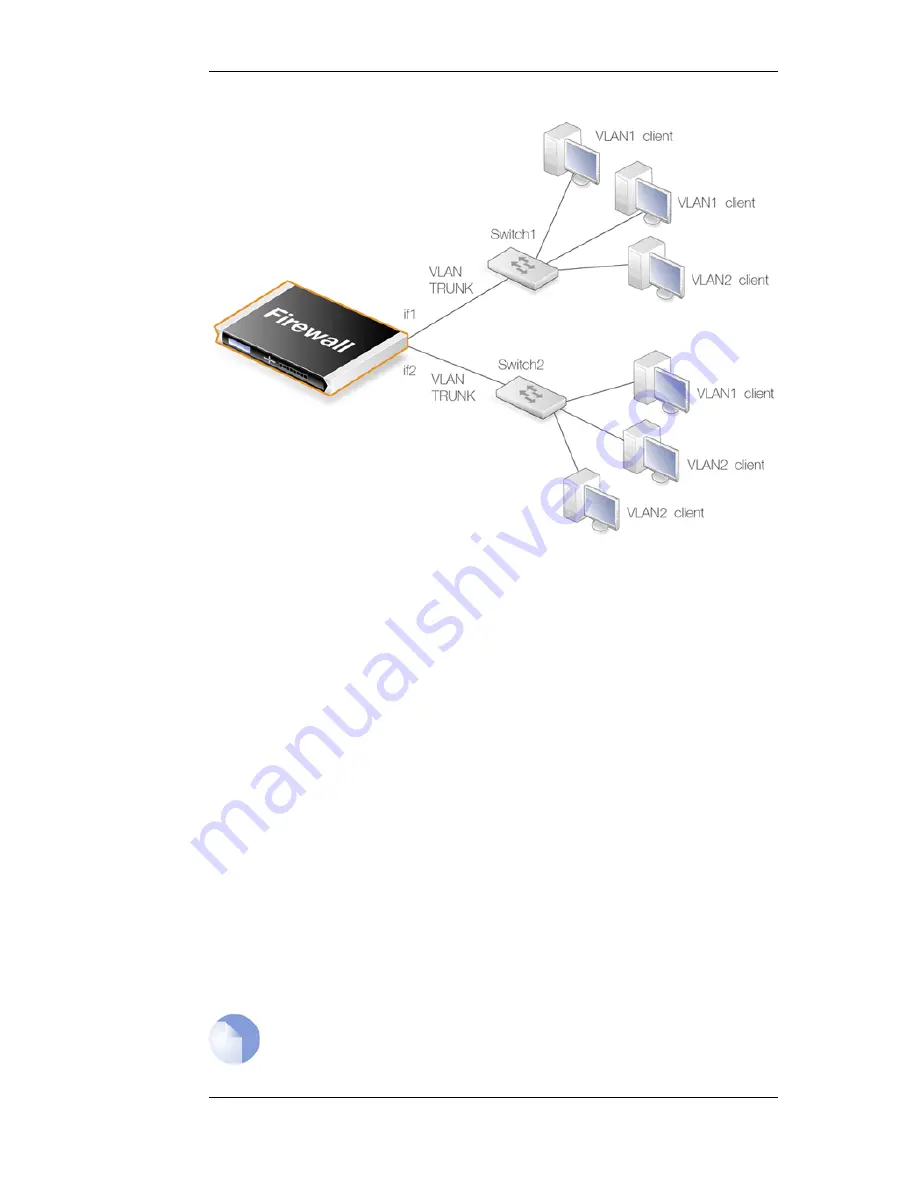
Figure 3.1. VLAN Connections
With NetDefendOS VLANs, the physical connections are as follows:
•
One of more VLANs are configured on a physical NetDefend Firewall interface and this is
connected directly to a switch. This link acts as a VLAN trunk. The switch used must support
port based VLANs. This means that each port on the switch can be configured with the ID of the
VLAN or VLANs that a port is connected to. The port on the switch that connects to the firewall
should be configured to accept the VLAN IDs that will flow through the trunk.
In the illustration above the connections between the interfaces if1 and if2 to the switches
Switch1 and Switch2 are VLAN trunks.
•
Other ports on the switch that connect to VLAN clients are configured with individual VLAN
IDs. Any device connected to one of these ports will then automatically become part of the
VLAN configured for that port. In Cisco switches this is called configuring a Static-access
VLAN.
On Switch1 in the illustration above, one interface is configured to be dedicated to VLAN1 and
two others are dedicated to VLAN2.
The switch could also forward trunk traffic from the firewall into another trunk if required.
•
More than one interface on the firewall can carry VLAN trunk traffic and these will connect to
separate switches. More than one trunk can be configured to carry traffic with the same VLAN
ID.
Note: 802.1ad is not supported
NetDefendOS does not support the IEEE 802.1ad (provider bridges) standard which
allows VLANs to be run inside other VLANs.
3.3.3. VLAN
Chapter 3. Fundamentals
103
Summary of Contents for NetDefend DFL-260E
Page 27: ...1 3 NetDefendOS State Engine Packet Flow Chapter 1 NetDefendOS Overview 27...
Page 79: ...2 7 3 Restore to Factory Defaults Chapter 2 Management and Maintenance 79...
Page 146: ...3 9 DNS Chapter 3 Fundamentals 146...
Page 227: ...4 7 5 Advanced Settings for Transparent Mode Chapter 4 Routing 227...
Page 241: ...5 4 IP Pools Chapter 5 DHCP Services 241...
Page 339: ...6 7 Blacklisting Hosts and Networks Chapter 6 Security Mechanisms 339...
Page 360: ...7 4 7 SAT and FwdFast Rules Chapter 7 Address Translation 360...
Page 382: ...8 3 Customizing HTML Pages Chapter 8 User Authentication 382...
Page 386: ...The TLS ALG 9 1 5 The TLS Alternative for VPN Chapter 9 VPN 386...
Page 439: ...Figure 9 3 PPTP Client Usage 9 5 4 PPTP L2TP Clients Chapter 9 VPN 439...
Page 450: ...9 7 6 Specific Symptoms Chapter 9 VPN 450...
Page 488: ...10 4 6 Setting Up SLB_SAT Rules Chapter 10 Traffic Management 488...
Page 503: ...11 6 HA Advanced Settings Chapter 11 High Availability 503...
Page 510: ...12 3 5 Limitations Chapter 12 ZoneDefense 510...
Page 533: ...13 9 Miscellaneous Settings Chapter 13 Advanced Settings 533...













































